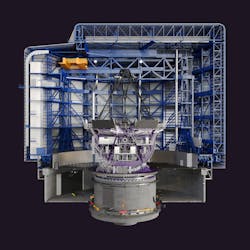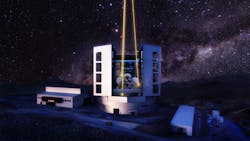And the Award to Design the Giant Magellan Telescope Goes to…
When the Giant Magellan Telescope is operational in the late 2020s, it will produce images that are 10 times greater than Hubble Space Telescope and four times the James Webb Space Telescope.
But before this feat can be achieved, the structure must be designed and built. That privilege has been awarded to IDOM, a renowned engineering and architecture firm headquartered in Bilbao, Spain.
Designing and building the 4,800 metric ton upper enclosure at the Las Campanas Observatory in the Chilean Atacama Desert will be a particularly challenging engineering accomplishment. The engineers will need to protect the telescope’s giant mirrors from extreme earthquakes and weather, modulate wind speeds and temperatures, and reveal seven of the world’s largest mirrors for unobstructed science observations of the night sky.
A Winning Bid
IDOM’s Advanced Design and Analysis group has global experience developing special and moveable structures, test systems, instruments and facilities for astronomers, nuclear and particle physicists, as well as other advanced research fields.
“Following an extensive designer evaluation, IDOM proved to have the necessary knowledge, experience and expertise to solve the design challenges associated with the environmental conditions at the telescope site, especially the local seismic and weather conditions,” said Dr. Bruce Bigelow, the Giant Magellan Telescope’s site, enclosure and facilities manager. “Adding the size, functionality and environmental conditions to the design challenge, efficient manufacturing—especially off-site—and modular construction are key aspects to making the construction of the enclosure safe, reliable, and affordable. We’re delighted to work with IDOM to make the enclosure design a reality.”
This wouldn’t be the first astronomical project for IDOM, though. The firm took on the development of components for the Gran Telescopium Canarias, as well as the enclosure and thermal systems for the Daniel K. Inouye Solar Telescope; consulted for the Thirty Meter Telescope; designed the Maunakea Spectroscopic Explorer; and did the conceptual design for the European Extremely Large Telescope.
Seismic Protection
IDOM noted that the Giant Magellan Telescope’s 65-meter-tall enclosure must overcome two key challenges in protecting its giant mirrors—extreme earthquakes and weather.
The Giant Magellan Telescope is being constructed at Las Campanas Observatory in the Chilean Atacama Desert, one of the driest deserts and most seismically active regions in the world. The region averages six earthquakes every month and will expose the telescope and enclosure to regular seismic events.
For this reason, the enclosure design will have to provide the telescope pier with a seismic isolation system that can withstand the strongest earthquakes expected over the 50-year lifetime of the observatory.
Last year, Machine Design reported on the Giant Magellan Telescope’s innovative seismic protection design. The seismic isolation system is a circular array of 24 single friction pendulum isolators that support the telescope and its pier and protect the telescope’s optical components and instruments from active ground motion caused by a major earthquake. This system allows the telescope to return to operations within hours after frequent (but less intense) seismic events expected each month.
IDOM noted that a robust automated climate control system will also be integral to the design. The engineers noted that the system will help manage extreme weather patterns by keeping high winds and temperature swings from impacting the telescope’s giant mirrors and advanced optical technologies.
Reliability and Sustainability
The enclosure will be designed with sustainability top of mind, using the latest technologies and environmental design practices. IDOM explained that the enclosure design will use a variety of constructability approaches, and will employ both local materials and a local workforce to control costs and minimize construction and operational carbon footprints.
The construction site currently relies on the Chilean National Electric System, which is predominately supplied by renewable energy. The GMTO Corporation plans to erect a powerline to connect to the Chilean grid and to take advantage of existing renewable energy sources. Incorporating energy and water efficient technologies, including a greywater treatment and recovery systems to significantly reduce water usage, are also part of the arrangement.
The Giant Magellan Telescope is the work of an international consortium of leading universities and research institutions representing five countries. Explore the design here.



